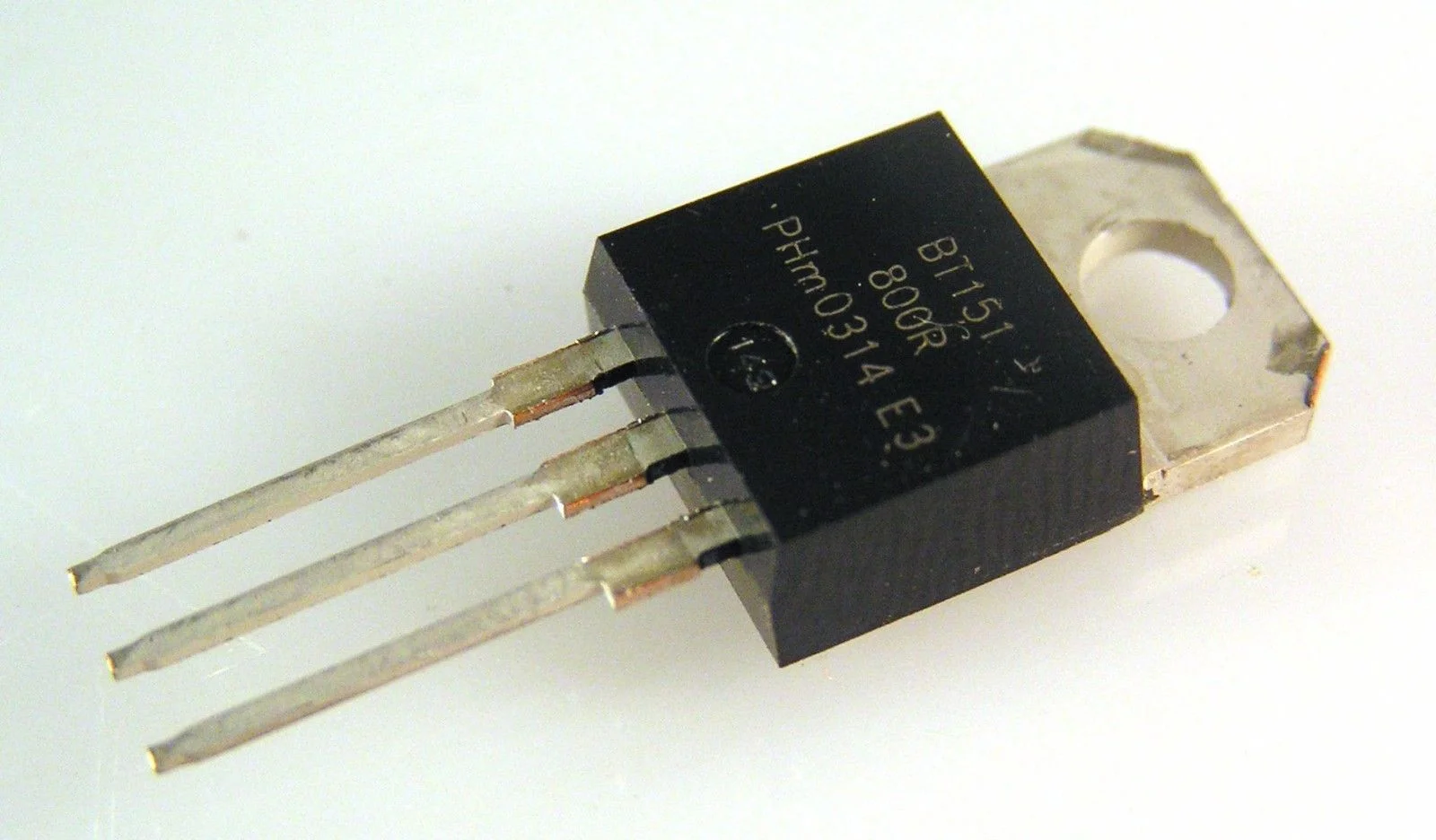
The BT151 SCR is a strong silicon controlled rectifier. It works well for switching AC and DC in many circuits. This thyristor can handle medium power. It is good for motor control, light dimming, and power control. The BT151 can carry 12A of current. It comes in a TO-220 package. This package makes it easy to mount and helps it stay cool. Many engineers pick the BT151 SCR because it works well and is reliable. The BT151 datasheet shows great numbers. It has a top anode-cathode voltage of 650V. It can also handle a pulsed DC current of 120A.
| Parameter | Value |
|---|---|
| Maximum anode-cathode voltage (off state) | 650 V |
| Maximum RMS current | 12 A |
| Pulsed DC current | 120 A |
| Gate trigger current | 15 mA max. |
| Holding current | 20 mA max. |
| Latching current | 40 mA max. |
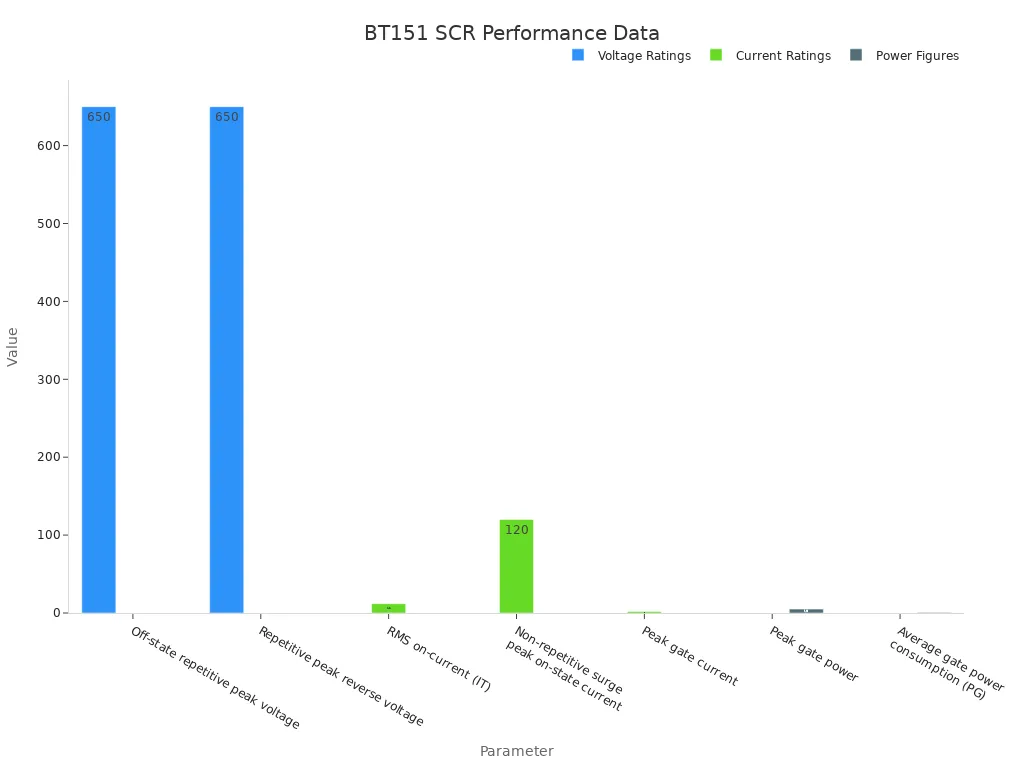
Key Takeaways
-
The BT151 SCR is a strong silicon controlled rectifier. It can handle up to 650V and 12A. This makes it good for motor control, light dimming, and power switching.
-
Its TO-220 package helps get rid of heat. It is easy to mount. This keeps it working well even with heavy loads. It works in high temperatures from -40°C to 125°C.
-
The device turns on with a small gate current. It stays on until the current drops below a holding level. This lets you control AC and DC power easily.
-
You must know the pinout: anode, cathode, gate, and tab. This is important for safe and correct circuit connections. It stops damage and makes sure it works right.
-
Always look at the BT151 datasheet before you use it. Check the voltage, current, and thermal limits. Use heat sinks in your circuits to keep the device safe and help it work better.
BT151 SCR Overview
Function
The BT151 SCR is a silicon controlled rectifier. It works like a switch in power circuits. This thyristor lets current move one way when its gate gets a small current. After it turns on, the BT151 stays on until the current drops low. This latching makes it good for AC and DC power control. The BT151 SCR can handle up to 650V and 12A. People use it in lamp dimmers, motor controllers, and ignition systems.
The BT151 SCR can manage big currents at low voltages. It reacts fast to changes in current. This helps protect circuits from sudden surges. It works in many temperatures, from -40°C to 125°C. This means it fits both home and industrial uses. The BT151 SCR can handle short bursts of 120A without damage.
| Parameter | Value | Description/Significance |
|---|---|---|
| Maximum Voltage | 650 V | Maximum anode-cathode voltage rating (off state) |
| Maximum RMS Current | 12 A | Maximum continuous current the SCR can handle |
| Pulsed DC Current | 120 A | Maximum pulsed current rating |
| Gate Trigger Current | 15 mA max | Minimum current required to trigger conduction |
| Holding Current | 20 mA max | Minimum current to maintain conduction after triggering |
| Latching Current | 40 mA max | Minimum current to latch the SCR into conduction state |
The BT151 SCR shows strong gate power and current. It can handle big loads and keeps working well during surges. This makes it a good choice for switching and power control.
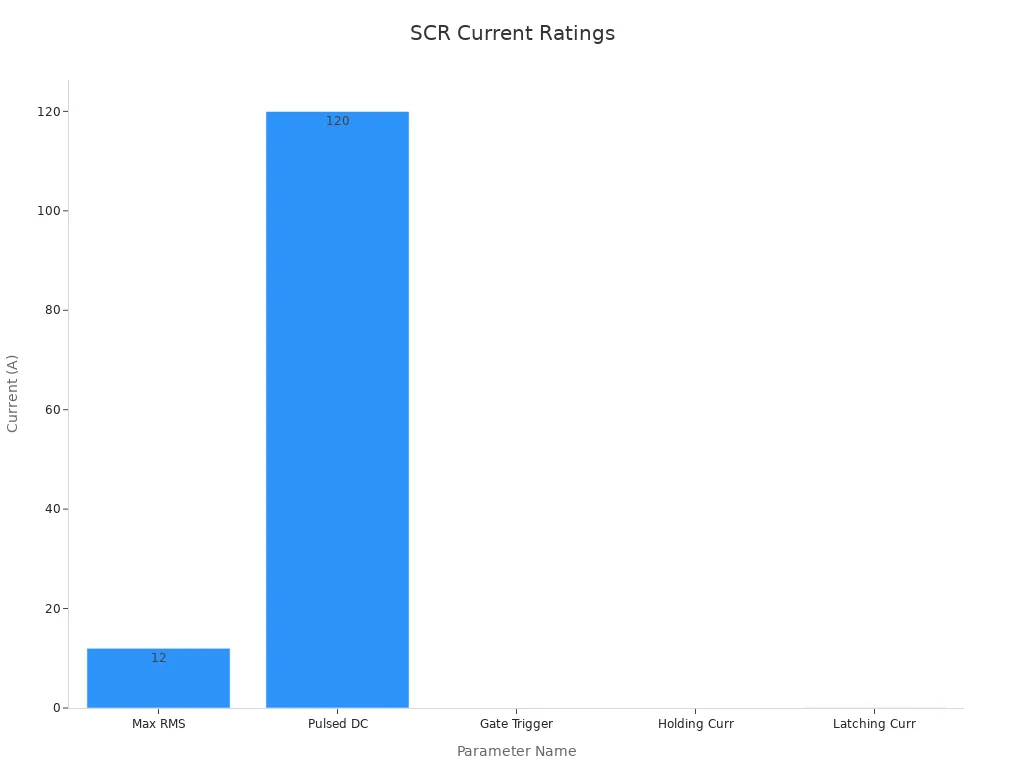
Features
The BT151 SCR has many features that help in power electronics. These features help engineers make safe and efficient circuits.
-
The silicon controlled rectifier can handle big currents at low voltages. This makes it good for AC/DC modulation and motor control.
-
It reacts fast to current changes, which helps keep things safe and steady.
-
The device stays cool and stable even with heavy loads.
-
It works in temperatures from -40°C to 125°C and can take surge currents up to 120A.
-
The BT151 comes in a TO-220 package, which helps it lose heat and is easy to mount.
-
Its gate trigger current is low, so it is easy to control and switch safely.
-
The SCR latches on after being triggered, so it does not need a constant gate signal.
-
The device meets safety rules like IEC-80134 and is RoHS compliant, so it is safe and reliable.
-
People use it for current detection, motor speed control, voltage stability, and temperature control in appliances.
| Aspect | Details |
|---|---|
| Device Type | Silicon Controlled Rectifier (SCR), also called a Thyristor |
| Package | TO-220 |
| Current Rating | RMS on-state current: 12A, Standard on-state current: 7.5A |
| Voltage Ratings | Peak off-state voltage: 650V, Max repetitive forward blocking voltage: 500V |
| Gate Trigger Current | 1mA to 15mA, Max gate trigger voltage: 1.5V |
| Holding Current | Max 20mA |
| Surge Current Rating | 132A |
| Thermal Performance | High thermal cycling performance |
| Key Features | High bidirectional blocking voltage, high reliability, surge current capacity |
| Pin Configuration | Pin1: Cathode, Pin2: Anode, Pin3: Gate, Pin4: Tab (connected to anode) |
| Operation Principle | Conducts when gate is triggered; uni-directional current flow; latches until current < holding current |
| Typical Applications | Power switching, motor control, ignition circuits, static switching, protection circuits, CDI (Capacitive Discharge Ignition) |
| Testing Method | Multimeter test verifying diode action between gate and cathode terminals |
| Equivalent Devices | TYN208, BT152, 2N6508; Alternatives: BTA16, S6010, BTB12600B |
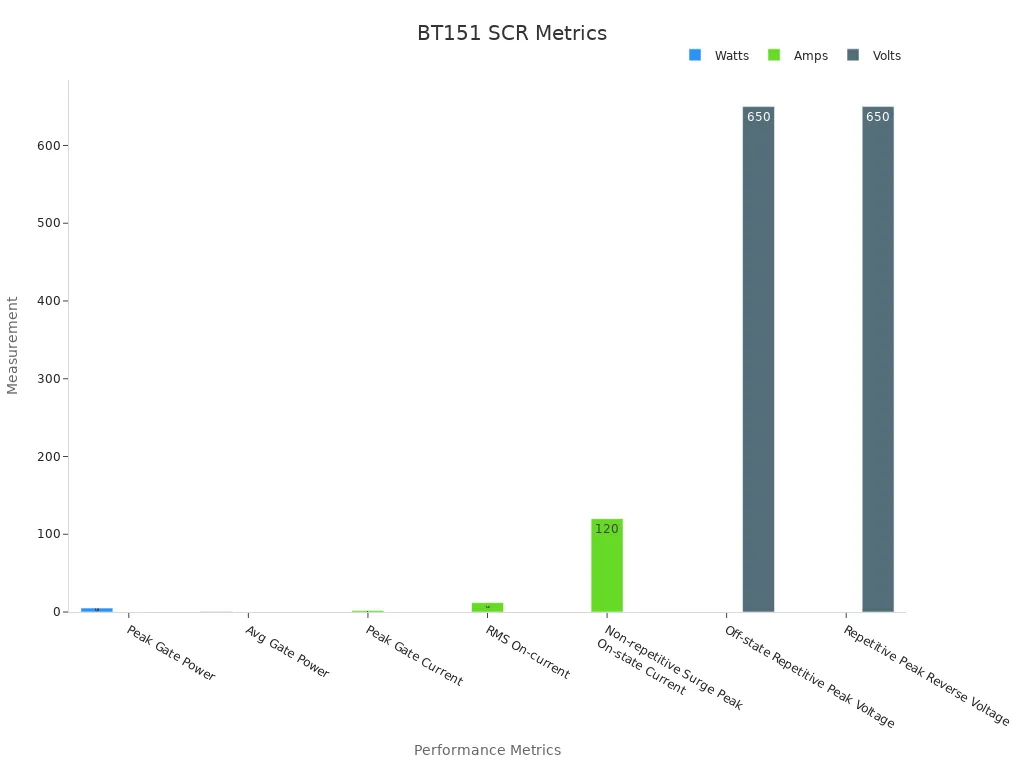
Note: The BT151 SCR is strong and reliable. It is a trusted part for engineers who work on power control, safety, and automation projects.
BT151 Pinout
Pin Diagram
The BT151 uses a TO-220AB package. This is a popular package for power parts. It has three main pins and a metal tab. The anode connects to the positive side. The gate pin is used to control the device. The cathode connects to the negative side. The metal tab is joined to the anode inside. The tab helps move heat away from the part. Most datasheets show a simple diagram with labels for each pin. This makes it easy for engineers to find the right pin.
Tip: Always look at the datasheet for the pin layout before you solder or put the BT151 in a circuit. This helps you avoid mistakes and keeps the part safe.
Pin Description
The pin setup for the BT151 SCR is simple to learn. Each pin has its own job in how the BT151 works. The table below shows what each pin does:
| Pin Number | Pin Name | Function Description |
|---|---|---|
| 1 | Cathode | Conventional current flows out of the cathode. |
| 2 | Anode | Conventional current flows into the anode. |
| 3 | Gate | Controls conduction between the anode and cathode. |
| 4 | Tab | Electrically connected to the anode for heat dissipation. |
The anode is the positive side and lets current go into the BT151. The cathode is the negative side and lets current leave. The gate pin turns the device on when it gets a small current. The tab is part of the case and helps get rid of heat. The tab is also joined to the anode inside.
-
The BT151 SCR is often used in crowbar circuits for over-voltage protection.
-
These circuits use the BT151, resistors, zener diodes, fuses, and transistors.
-
The gate pin turns on the SCR when the voltage gets too high, set by a zener diode.
-
When this happens, the BT151 connects the power rails to ground to protect parts.
-
The pinout makes it simple to use the BT151 in many projects.
The clear labels and easy design of the BT151 pinout help people build good circuits. Knowing what each pin does helps keep projects safe and working well.
BT151 Specifications
Electrical Ratings
The BT151 SCR is known for its strong electrical specs. It can handle high voltage and big currents. This makes it useful in many power circuits. The BT151 can let 12A of current flow when it is on. It can also take a surge current up to 120A. This means it can survive short bursts of high current.
The voltage rating goes up to 650V. This lets the SCR work in both AC and DC circuits. The gate trigger current is low, with a max of 15mA. This makes it easy to control with simple circuits. The holding current is also low at 20mA. The SCR stays on with only a small current.
The on-state voltage drop is important too. For the BT151, it is 1.75V at most. This low drop helps save power when the device is on.
Here is a table that shows the main electrical specs for the BT151 SCR:
| Parameter | Value | Unit |
|---|---|---|
| Maximum Voltage | 650 | V |
| On-State Current (RMS Max) | 12 | A |
| Surge On-State Current (Non-repetitive) | 120 | A |
| Gate Trigger Current (Max) | 15 | mA |
| Holding Current (Max) | 20 | mA |
| On-State Voltage (Max) | 1.75 | V |
| Peak Gate Power | 5 | W |
| Gate Current | 2 | A |
| Repetitive Peak Off-State Voltage | 500 | V |
| Off-State Current (Max) | 0.5 | mA |
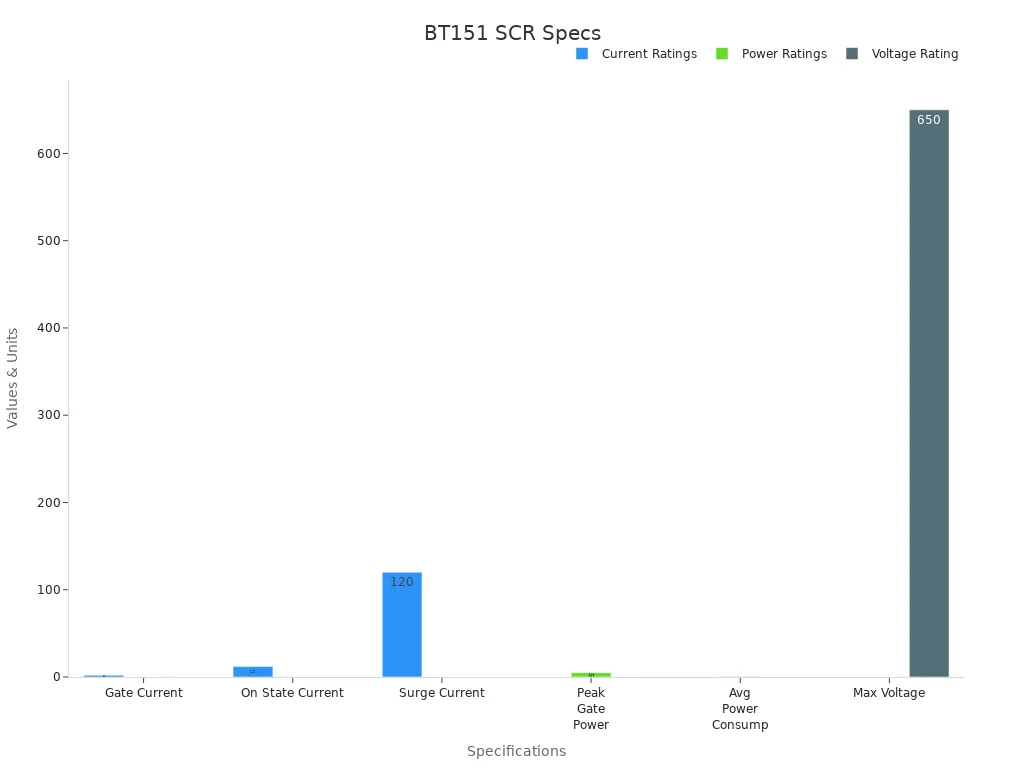
The BT151 SCR uses a TO-220 package. This package helps it lose heat and is easy to mount. The device has strong latching ability. Once it turns on, it stays on until the current drops below the holding value. The BT151 can handle fast voltage changes without turning on by mistake.
The BT151 SCR’s electrical specs make it a good choice for switching, protection, and control in power electronics.
Thermal Ratings
Thermal specs are important for power devices. The BT151 SCR can work in temperatures from -40°C to 125°C. This lets it work in both cold and hot places. The storage temperature range is -40°C to 150°C. The SCR stays safe even when not being used.
The TO-220 package helps the BT151 get rid of heat. Good heat loss keeps the device stable when lots of current flows. The average power use is low, only 0.5W. This means you do not need much extra cooling.
Here is a table with the main thermal specs for the BT151 SCR:
| Parameter | Value | Unit |
|---|---|---|
| Operating Temperature Range | -40 to 125 | °C |
| Storage Temperature Range | -40 to 150 | °C |
| Average Power Consumption | 0.5 | W |
| Surge Current (Non-repetitive) | 132 | A |
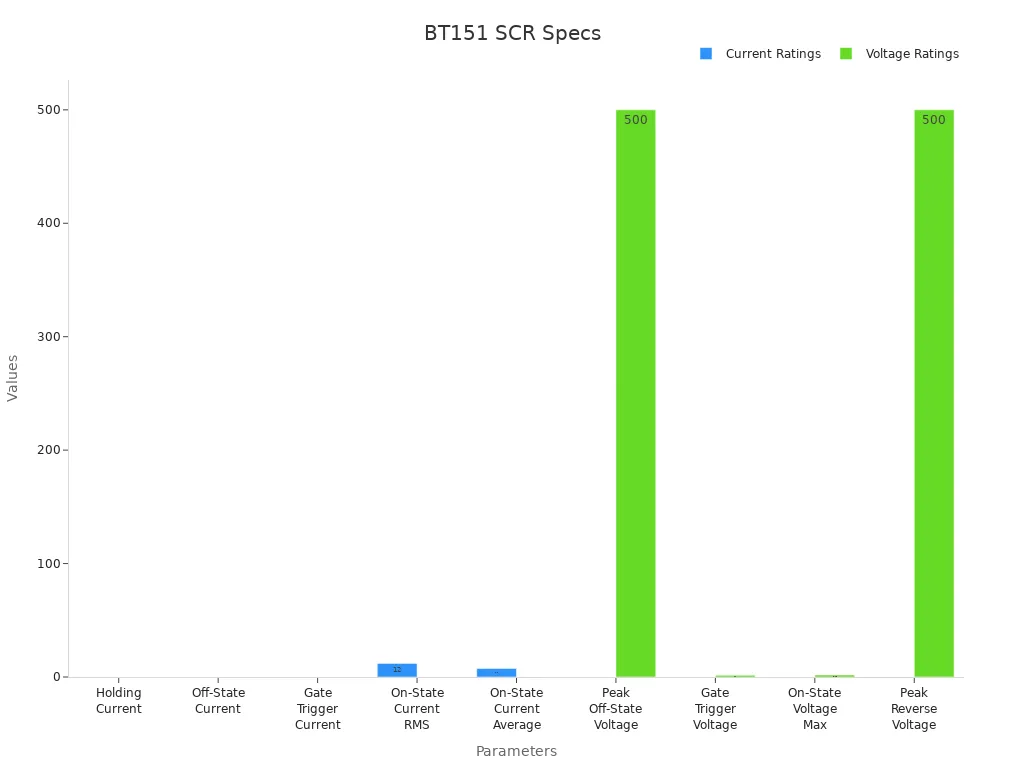
The BT151 SCR’s specs show it can handle both electrical and heat stress. This makes it a good part for many power control projects.
Always check the specs before using the BT151 in a new design. This helps keep your project safe and working well.
BT151 Datasheet
Key Parameters
The bt151 datasheet has important facts about the device. Engineers use these facts to make sure the bt151 works right in circuits. The datasheet lists main things like voltage, current, and power ratings. It also tells the highest temperature and surge current allowed. These numbers help people pick the best part for their project.
Here is a table with some key parameters from the bt151 datasheet:
| Parameter | Value | Unit |
|---|---|---|
| Maximum Voltage | 650 | V |
| RMS On-State Current | 12 | A |
| Surge Current | 120 | A |
| Gate Trigger Current | 15 | mA |
| Holding Current | 20 | mA |
| On-State Voltage Drop | 1.75 | V |
| Operating Temperature | -40 to 125 | °C |
Note: Always check the bt151 datasheet for the newest and most correct values before using the device.
Reading the Datasheet
The bt151 datasheet helps people learn how to use the SCR safely. It shows how much current the device can take and what voltage it can stop. The datasheet also explains how to hook up the pins and test the device. People should look at the graphs and tables to see how the bt151 acts in different cases.
To use the bt151 datasheet well, do these steps:
-
Find the highest ratings for voltage and current.
-
Check the gate trigger current and holding current.
-
Look at the heat limits so it does not get too hot.
-
Review the pinout picture to wire it right.
Official datasheets are on trusted websites. Users can go to the maker’s site or big electronics parts sites to get the bt151 datasheet as a PDF.
Tip: Reading the bt151 datasheet before building a circuit helps stop mistakes and keeps your project safe.
BT151 Circuits and Uses
Example Circuits
Engineers use the BT151 in many real circuits for power control. One common use is to control the speed of a single-phase induction motor. In this setup, the BT151 works like a switch. It controls how much voltage goes to the motor. By changing when the SCR turns on, the circuit can make the motor go faster or slower. A study shows a MATLAB/Simulink model using the BT151 to control armature voltage in a DC motor. The model uses different converter circuits, like half, semi, and full converters. These show how the thyristor can manage power flow.
Another project uses a cycloconverter circuit to control the speed of single-phase induction motors. The BT151 SCR helps change the AC supply’s frequency. This lets motors run at different speeds. This method works for homes and factories.
A real example uses the BT151 in a capacitive discharge ignition (CDI) circuit. In this design, the SCR acts as a fast switch. When it gets triggered, it lets a capacitor send energy through an ignition coil. This makes a spark to start an engine. This shows the BT151 can handle timing and switching in high-voltage circuits.
Tip: Always check the datasheet and use good heat sinks when building circuits with the BT151. This keeps your project safe.
Applications
The BT151 is used in many different ways. It is popular for controlling motors, lights, and heaters. The SCR can switch both AC and DC loads. This makes it useful for many power jobs. In motor control circuits, the BT151 changes speed and direction by controlling current. Engineers use it in voltage regulation circuits to keep output steady.
-
The BT151 is used in:
-
Motor speed control systems
-
Lighting dimmers for homes and theaters
-
Heater control circuits
-
Static switching for machines in factories
-
Circuit protection, like crowbar and inrush current protection
-
Ignition systems for cars and small engines
-
Manufacturers say the BT151 is reliable and turns on quickly. Distributors with quality checks support its use in factories and cars. The BT151 SCR is used in homes and factories, from simple light control to advanced motor drives. Its ability to handle high voltage and current makes it a trusted part for engineers working on power control projects.
Example: Simple Motor Speed Controller Circuit
AC Supply
|
[BT151 SCR]
|
[Motor Load]
|
Ground
A microcontroller or phase control circuit triggers the gate of the BT151, adjusting the motor speed.
Note: The BT151 is very useful for controlling motors and other loads. This makes it important in modern power electronics.
The BT151 SCR is known for handling high current and voltage. Many engineers use it for power control jobs. They look at the datasheet to use it safely. Learning the specs helps people not make mistakes. The BT151 works in circuits for motors, lights, and safety. Anyone who likes power electronics can try new projects with this SCR.
FAQ
What is the main use of the BT151 SCR?
The BT151 SCR works best in power control circuits. Engineers use it for switching, motor speed control, and light dimming. It handles high current and voltage, making it a good choice for home and industrial projects.
How does someone trigger the BT151 SCR?
A small current sent to the gate pin triggers the BT151 SCR. This current usually comes from a control circuit or microcontroller. Once triggered, the SCR allows current to flow between the anode and cathode.
Can the BT151 SCR switch both AC and DC loads?
Yes, the BT151 SCR can switch both AC and DC loads. It works well in circuits that need to control power flow in either type of system.
What happens if the BT151 SCR overheats?
If the BT151 SCR overheats, it may fail or stop working. Using a heat sink and checking the datasheet for thermal limits helps prevent damage.
Where can someone find the official BT151 datasheet?
People can find the official BT151 datasheet on the manufacturer’s website or trusted electronics parts distributors. The datasheet gives all the important ratings and pinout details.
Written by Jack from AIChipLink.
AIChipLink, one of the fastest-growing global independent electronic components distributors in the world, offers millions of products from thousands of manufacturers, and many of our in-stock parts is available to ship same day.
We mainly source and distribute integrated circuit (IC) products of brands such as Broadcom, Microchip, Texas Instruments, Infineon, NXP, Analog Devices, Qualcomm, Intel, etc., which are widely used in communication & network, telecom, industrial control, new energy and automotive electronics.
Empowered by AI, Linked to the Future. Get started on AIChipLink.com and submit your RFQ online today!














